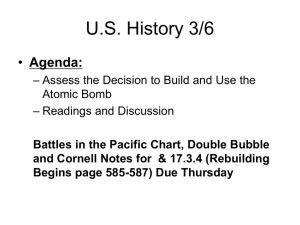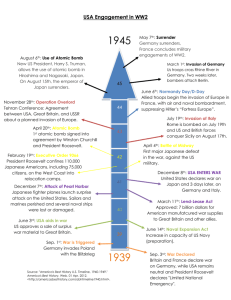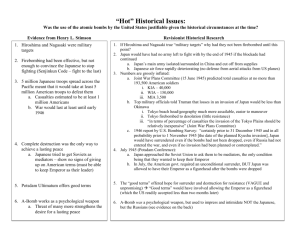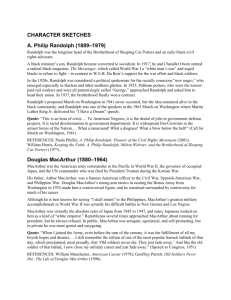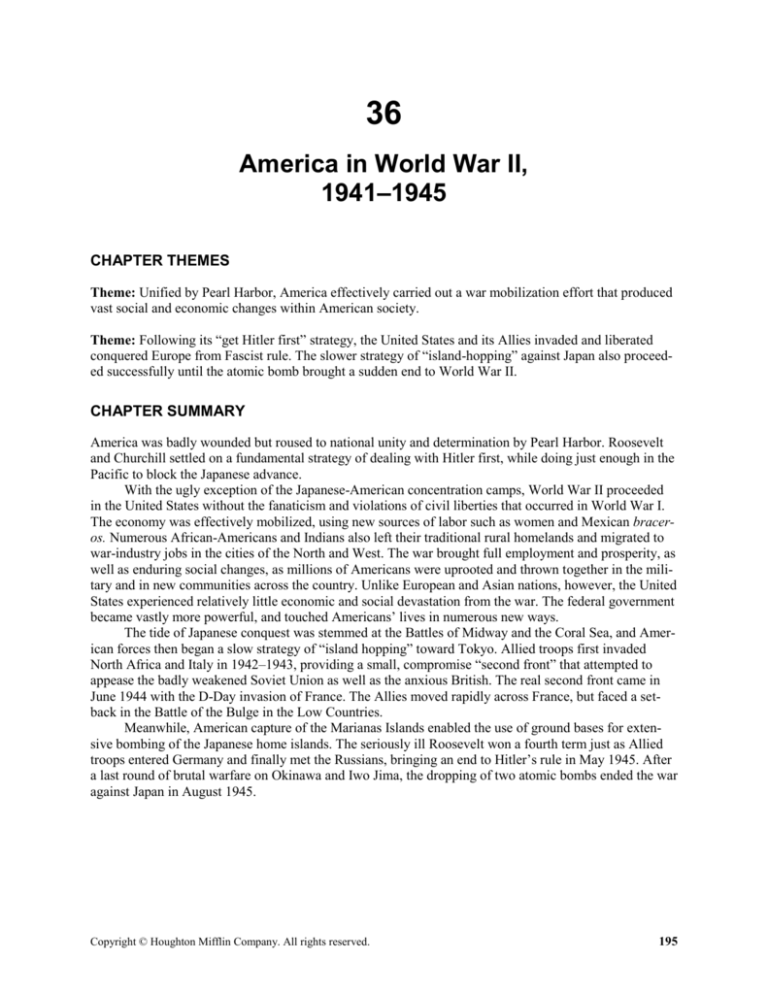
36
America in World War II,
1941–1945
CHAPTER THEMES
Theme: Unified by Pearl Harbor, America effectively carried out a war mobilization effort that produced
vast social and economic changes within American society.
Theme: Following its “get Hitler first” strategy, the United States and its Allies invaded and liberated
conquered Europe from Fascist rule. The slower strategy of “island-hopping” against Japan also proceeded successfully until the atomic bomb brought a sudden end to World War II.
CHAPTER SUMMARY
America was badly wounded but roused to national unity and determination by Pearl Harbor. Roosevelt
and Churchill settled on a fundamental strategy of dealing with Hitler first, while doing just enough in the
Pacific to block the Japanese advance.
With the ugly exception of the Japanese-American concentration camps, World War II proceeded
in the United States without the fanaticism and violations of civil liberties that occurred in World War I.
The economy was effectively mobilized, using new sources of labor such as women and Mexican braceros. Numerous African-Americans and Indians also left their traditional rural homelands and migrated to
war-industry jobs in the cities of the North and West. The war brought full employment and prosperity, as
well as enduring social changes, as millions of Americans were uprooted and thrown together in the military and in new communities across the country. Unlike European and Asian nations, however, the United
States experienced relatively little economic and social devastation from the war. The federal government
became vastly more powerful, and touched Americans’ lives in numerous new ways.
The tide of Japanese conquest was stemmed at the Battles of Midway and the Coral Sea, and American forces then began a slow strategy of “island hopping” toward Tokyo. Allied troops first invaded
North Africa and Italy in 1942–1943, providing a small, compromise “second front” that attempted to
appease the badly weakened Soviet Union as well as the anxious British. The real second front came in
June 1944 with the D-Day invasion of France. The Allies moved rapidly across France, but faced a setback in the Battle of the Bulge in the Low Countries.
Meanwhile, American capture of the Marianas Islands enabled the use of ground bases for extensive bombing of the Japanese home islands. The seriously ill Roosevelt won a fourth term just as Allied
troops entered Germany and finally met the Russians, bringing an end to Hitler’s rule in May 1945. After
a last round of brutal warfare on Okinawa and Iwo Jima, the dropping of two atomic bombs ended the war
against Japan in August 1945.
Copyright © Houghton Mifflin Company. All rights reserved.
195
196
Chapter 36
DEVELOPING THE CHAPTER: SUGGESTED LECTURE OR DISCUSSION TOPICS
Explain the basic strategic military decisions of the war. The emphasis might be on the fact that
there were, in a sense, two separate wars that had to be conducted simultaneously and that the European war required delicate political and military coordination with Britain and Russia.
REFERENCE:
H. P. Willmott, The Great Crusade: A New Complete History of the Second World
War (1990).
Describe the social and economic changes brought by the war. Particular attention could be given to
war-spawned prosperity after the depression and to the beginnings of the Sunbelt migrations that
continued in the postwar era, including the African-American exodus to the North and West.
REFERENCE: John W. Jeffries,
Wartime America: The World War II Homefront (1996).
Examine the major military battles in Europe, Asia, and the Middle East, and their relation to the
political tensions among the United States, Britain, and the Soviet Union.
REFERENCE:
Gerhard Weinberg, A World at Arms (1990); David M. Kennedy, Freedom from Fear
(1999).
Analyze the events of the war against Japan, including the development and use of the atomic
bomb. The emphasis might be on the controversy over why the bomb was used.
REFERENCES:
Martin J. Sherwin, A World Destroyed: The Atomic Bomb and the Grand Alliance
(1975); Ronald Spector, Eagle Against the Sun: The American War with Japan (1985).
FOR FURTHER INTEREST: ADDITIONAL CLASS TOPICS
Examine the role of women during the war. Discuss the text’s point (p. 837) that American women’s lives were not altered as much as were the lives of women in other belligerent nations.
Discuss the varieties of warfare conducted by American forces during the conflict, ranging from the
savage island fighting in the Pacific to the strategic bombing of German and Japanese military and
civilian targets.
Focus on Roosevelt, Churchill, and Stalin as the “Big Three” wartime leaders. Perhaps use their
major decision-making meetings—Casablanca, Teheran, Yalta—to define the stages of the war.
Analyze the immediate and long-term consequences of the war. Show how the basic international
structure of the postwar world was determined by World War II, including the rivalry between the
United States and the Soviet Union.
Copyright © Houghton Mifflin Company. All rights reserved.
America in World War II, 1941–1945
197
CHARACTER SKETCHES
A. Philip Randolph (1889–1979)
Randolph was the longtime head of the Brotherhood of Sleeping Car Porters and an early black civil
rights advocate.
A black minister’s son, Randolph became converted to socialism. In 1917 he and Chandler Owen
started a radical black magazine, The Messenger, which called World War I a “white man’s war” and
urged blacks to refuse to fight—in contrast to W. E. B. Du Bois’s support for the war effort and black
soldiers.
In the 1920s Randolph was considered a political spokesman for the racially conscious “new negro,” who emerged especially in Harlem and other northern ghettos. In 1925 Pullman porters, who were
the lowest-paid rail workers and were all patronizingly called “George,” approached Randolph and asked
him to head their union. In 1937 the brotherhood finally won a contract.
Randolph’s proposed March on Washington in 1941 never occurred, but the idea remained alive in
the black community, and Randolph was one of the speakers at the 1963 March on Washington where
Martin Luther King, Jr. delivered his “I Have a Dream” speech.
Quote: “This is an hour of crisis.…To American Negroes, it is the denial of jobs in government defense
projects. It is racial discrimination in government departments. It is widespread Jim-Crowism in the
armed forces of the Nation.…What a runaround! What a disgrace! What a blow below the belt!” (Call for
March on Washington, 1941)
REFERENCE:
Paula Pfeffer, A. Philip Randolph: Pioneer of the Civil Rights Movement (2001). William
Harris, Keeping the Faith: A. Philip Randolph, Milton Webster, and the Brotherhood of Sleeping Car
Porters (1977).
Douglas MacArthur (1880–1964)
MacArthur was the American army commander in the Pacific in World War II, the governor of occupied
Japan, and the U.N. commander who was fired by President Truman during the Korean War.
His father, Arthur MacArthur, was a famous American officer in the Civil War, Spanish-American
War, and Philippine War. Douglas MacArthur’s strong-arm tactics in ousting the “Bonus Army” from
Washington in 1932 made him a controversial figure, and he remained surrounded by controversy for
much of his career.
Although he is best known for saying “I shall return” to the Philippines, MacArthur’s greatest military accomplishment in World War II was actually his difficult battles in New Guinea and Los Negros.
MacArthur was virtually the absolute ruler of Japan from 1945 to 1947, and many Japanese looked
on him as a kind of “white emperor.” Republicans several times approached MacArthur about running for
president, but he always refused. In public MacArthur was arrogant, egotistical, and self-promoting, but
in private he was more genial and easygoing.
Quote: “When I joined the Army, even before the turn of the century, it was the fulfillment of all my boyish hopes and dreams.…I still remember the refrain of one of the most popular barrack ballads of that day,
which proclaimed, most proudly, that ‘Old soldiers never die. They just fade away.’ And like the old soldier of that ballad, I now close my military career and just fade away.” (Speech to Congress, 1951)
REFERENCE: William Manchester,
American Caesar (1978); Geoffrey Parrett. Old Soldiers Never Die:
The Life of Douglas MacArthur (1996).
Copyright © Houghton Mifflin Company. All rights reserved.
198
Chapter 36
George Patton (1885–1945)
Patton was the American tank commander of World War II whose belligerent behavior and ideas made
him a focus of controversy.
Descended from Revolutionary and Confederate officers, Patton grew up captivated by tales of his
ancestors’ heroic military exploits. He was raised on his wealthy grandfather’s California estate and did
not attend school until he was twelve years old.
Patton’s tactical skill, especially in the conquest of Sicily, earned great praise, but he was nearly
fired from his command when he slapped and browbeat two shell-shocked GIs in an army hospital. Eisenhower reprimanded Patton but permitted him to remain at his post, deciding that his military ability
was necessary to the war.
After his spectacular tank breakthrough across France, he entered Germany but became embroiled
in further controversy when he advocated that American forces continue on and fight the Russians and
that they use Nazi officials and soldiers to do so. Patton was an extreme personality, known for his hysterical outbursts, his constant profanity, and his sentimentality.
Quote: “Americans love to fight, traditionally. All real Americans love the sting and clash of battle.
America loves a winner. America will not tolerate a loser.” (Speech to his troops before D-Day, 1944)
REFERENCE: Martin
Bluminson, Patton: The Man Behind the Legend, 1888–1945 (1985).
QUESTIONS FOR CLASS DISCUSSION
1. How did America’s domestic response to World War II differ from its reaction to World War I?
2. What was the wisest strategic decision in World War II, and what was the most questionable?
3. How were the European and Pacific wars similar, and how were they different?
4. What was the significance of the dropping of the atomic bomb, then and now?
MAKERS OF AMERICA: THE JAPANESE
Questions for Class Discussion
1. How were the Japanese immigrants similar to other immigrants from East Asia, such as the Chinese
and Filipinos? How were they different?
2. Should the World War II internment experience be seen as the most significant event in the JapaneseAmerican experience? How did it affect those who lived through it and their descendants?
Suggested Student Exercises
Use photographs or documents from early Japanese immigrants to glean their views of the United
States.
Consider the lives and careers of some prominent Japanese-Americans (such as Senator Daniel Inouye of Hawaii) in relation to the general Japanese-American experience.
Copyright © Houghton Mifflin Company. All rights reserved.
America in World War II, 1941–1945
199
MAKERS OF AMERICA: THE GREAT AFRICAN-AMERICAN MIGRATION
Questions for Class Discussion
1. Why did World War II finally provide the historic impetus to cause African-Americans to leave their
ancient conditions of oppression in the rural South?
2. What benefits did African-Americans gain from their migration north and west, and what problems
did they still have?
Suggested Student Exercises
Use photographs or other documents of the African-American migration to northern cities in the
World War II era. Examine what evidence the photographs provide about the economic conditions
of the migrants.
Read passages from one of the novels of the era, for example, Richard Wright’s Native Son or
Ralph Ellison’s Invisible Man, to illustrate the feelings and perceptions of African-Americans as
they entered life in the large northern cities. Wright’s autobiography, Black Boy, also explains the
conditions and aspirations that led many young blacks to leave the rural South and move north.
EXPANDING THE “VARYING VIEWPOINTS”
Gar Alperovitz, Atomic Diplomacy (rev. ed., 1985).
A view of the atomic bomb as aimed at Russia rather than Japan:
“The decision to use the weapon did not derive from overriding military considerations.…Before
the atomic bomb was dropped each of the Joint Chiefs of Staff advised that it was highly likely that
Japan could be forced to surrender ‘unconditionally,’ without use of the bomb and without an invasion.…Unquestionably, political considerations related to Russia played a major role in the decision; from at least mid-May American policy makers hoped to end the hostilities before the Red
Army entered Manchuria.…A combat demonstration was needed to convince the Russians to accept the American plan for a stable peace.”
Martin Sherwin, A World Destroyed (1975).
A view of the atomic bomb as primarily aimed at Japan:
“Caught between the remnants of war and the uncertainties of peace, policymakers and scientists
were trapped by their own unquestioned assumptions.…The secret development of this terrible
weapon, during a war fought for a total victory, created a logic of its own: a quest for a total solution of a set of related problems that appeared incapable of being resolved incrementally.…As Szilard first suggested in January 1944, the bomb might provide its own solution.…The decision to use
the bomb to end the war could no longer be distinguished from the desire to use it to stabilize the
peace.”
Copyright © Houghton Mifflin Company. All rights reserved.
200
Chapter 36
QUESTIONS ABOUT THE “VARYING VIEWPOINTS”
1. What does each of these historians see as American officials’ thinking about the relationship between
the bomb and the ending of the war against Japan?
2. What does each regard as the primary reason for the use of the bomb?
3. What conclusions might be drawn from each of these views about the political and moral justifications for dropping the bomb?
Copyright © Houghton Mifflin Company. All rights reserved.



